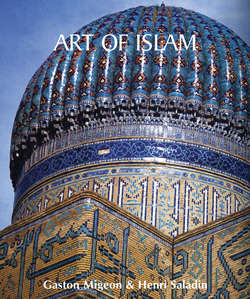Читать книгу Art of Islam - Gaston Migeon - Страница 11
Architecture
A – The Near and Middle East
The Al-Azhar Mosque in Cairo
ОглавлениеThe Al-Azhar Mosque, constructed in Cairo by Jauhar, a Sicilian slave, general in the army of Al Moizz and the first Fatimid sovereign of Egypt, has a larger central nave, lined by two rows of pillars, and a design that is quite different from that of Ibn Tulun and Amrou. It was transformed into a madrasa not long after it was founded and has been renovated and expanded many times. The entrance doorway dates back to Kaït Bey, including the minaret, whose base is visible (1468–1496); a wooden fence that dates back to Kaït Bey, located below the first portico, has recently been restored. Four additional naves were added to the mosque by Abder-Rahman Katkhoda, whose tomb is located in one of the rooms towards the mosque’s southern tip.
These additions notwithstanding, it seems that the podium indicates a central nave, flanked by a twin-row of columns, which is an ancient design that most likely originated from Tunisia (where it is found in the great mosques in Sfax, Tunis, Kairouan, Mehdiya, Beja, Gafsa, etc.), the cradle of the Fatimid dynasty. While the recent sections are made of stone, the ancient sections of Al-Azhar are constructed with bricks covered in a thick levelling plaster coat with ornamental engravings; it is the same in the small dome at the entrance.
The courtyard is accessible through a broad passage. This entrance, dominated by the minarets of nearby madrasas, presents recycled Roman and Byzantine columns and their capitals. The wall of the courtyard is overlaid with an openwork frieze richer than that of Tulun, above which hollowed out openwork melons with six-level indentations rise. Al-Azhar arcades that span between columns have a slender, unique form, like the arches of niches interposed between them: this type of arch, made of bricks, was used quite often in Persia. Since the Fatimid dynasty was Shiite like the Persians, this form might somewhat have been the result of dealings with Persia, or a Persian architect might even have influenced it. This use of arches was evident for a long time in Cairo, even under the Mameluke-Baharites, when all monuments were made of hewn stones.
